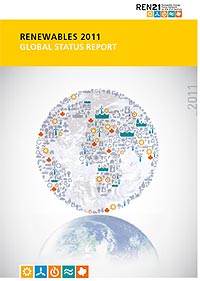Where in the world?!
Before we get to all those juicy statistics, REN21 came through with a little tech for infoporn addicts by debuting an online Renewables Interactive Map to coincide with the release of the group’s Renewables 2011 Global Status Report. As with all good interactive maps, it’s infinitely clickable and searchable. As a cleantech resource, it provides a handy overview of any given country’s progress on the renewables front, including info on things like incentives that help determine a region’s commitment to green energy along with a slew of other informative stats.
Speaking of stats, REN21’s aforementioned report, paints a relatively healthy picture for renewable energy, quite a feat considering the shaky global economy. Last year, according to the group’s findings, “renewable energy supplied an estimated 16% of global final energy consumption and delivered close to 20% of global electricity production.” In the U.S., renewables reached 10.9 percent of primary energy production, an increase of 5.6 percent from 2009, which helped close, and eventually surpass, the gap between green energy and nuclear power.
On the investment front, renewable energy companies, utility-scale generation and biofuel projects raked in $143 billion. Of that, China took in just over a third of that figure at $48.5 billion.
Prodding through policy
Policy is proving to be a big driver for the global green energy growth spurt. In 2010, 119 countries had policies and/or incentives in place to spur development, more than double the number of nations that had such support systems in place a scant five years earlier in 2005. According to the report, which was compiled by Worldwatch Institute Senior Fellow Janet Sawin and a team of researchers, more than half those countries hail from emerging markets.
Other highlights from the report include:
- Renewable capacity now comprises about a quarter of total global power-generating capacity and supplies close to 20% of global electricity, with most of this provided by hydropower.
- Developing countries (collectively) have more than half of global renewable energy power.
- The top five countries for non-hydro renewable power capacity were the United States, China, Germany, Spain, and India.
- China led the world in the installation of wind turbines and solar thermal systems and was the top hydropower producer in 2010. The country added an estimated 29 GW of grid-connected renewable capacity, for a total of 252 GW, an increase of 13% compared with 2009.
- Renewables accounted for about 26% of China’s total installed electric capacity in 2010, 18% of generation, and more than 9% of final energy supply.
- In the European Union, renewables represented an estimated 41% of newly installed electric capacity. While this share was significantly lower than the more than 60% of new capacity in 2009, more renewable power capacity was added in Europe than ever before.
- The EU exceeded its 2010 targets for wind, solar PV, concentrating solar thermal power, and heating/heat pumps. Countries including Finland, Germany, Spain, and Taiwan raised their targets, and South Africa, Guatemala, and India, among others, introduced new ones.
For a deep dive into the numbers, including some revealing details of what types of renewables are picking up steam (and where), download the full report here (pdf).


REN21: Renewables make up nearly 20 percent of global energy production http://j.mp/oqHMnS